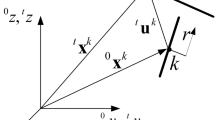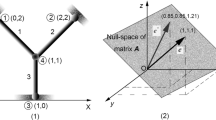Abstract
A prestressed cable–strut structure is generally flexible and exhibits strong coupling between its stress state and configuration. The zero-stress state offers the basis for design and analysis of cable–strut structures and has significant influence on the prestress state and the load state. Here, a computational method is proposed for seeking zero-stress states of symmetric cable–strut structures. By evaluating distributed static indeterminacy and symmetry representations using group theory, the active member with proper importance index and high-order symmetry is chosen from different types of members. Moreover, natural lengths and the involved elongations of the members are established from the initial prestresses and geometric properties. Then, based on the Newton method and the Moore–Penrose inverse theory, internal forces of the members are actively reduced. The structural configuration and tangent stiffness matrix are iteratively updated during the whole process from the prestress state to the zero-stress state. The feasibility and accuracy of the proposed approach are verified by some numerical examples, whereas the results are compared with analytical solutions and FEM simulation. The results show that one zero-stress configuration is associated with a specific prestress state, and the process between zero-stress state and prestress state is reversible. This work has theoretical significance for the design of novel cable–strut structures and provides a reference for the construction process of prestressed cable–strut structures in practical applications.










Similar content being viewed by others
References
Wang, B.: Cable-strut systems: part II—cable-strut. J. Constr. Steel Res. 45, 291–299 (1998)
Adam, B., Smith, I.: Tensegrity active control: multiobjective approach. J. Comput. Civ. Eng. 21, 3–10 (2007)
Kawaguchi, M., Tatemichi, I., Chen, P.S.: Optimum shapes of a cable dome structure. Eng. Struct. 21, 719–725 (1999)
Tran, H.C., Lee, J.: Advanced form-finding for cable-strut structures. Int. J. Solids Struct. 47, 1785–1794 (2010)
Montuori, R., Skelton, R.E.: Globally stable tensegrity compressive structures for arbitrary complexity. Compos. Struct. 179, 682–694 (2017)
Motro, R.: Tensegrity: Latest and Future Developments. In: Tensegrity, pp. 189–217. Butterworth-Heinemann, Oxford (2003)
Geiger, D.H., Stefaniuk, A., Chen, D.: The design and construction of two cable domes for the Korean Olympics. In: Proceedings of the IASS Symposium on Shells, Membranes and Space Frames, pp. 265–272. Elsevier Science Publishers BV, Osaka (1986)
Levy, M.P., Jing, T.F.: Floating saddle connections for the Georgia Dome, USA. Struct. Eng. Int. 4, 148–150 (1994)
Quagliaroli, M., Malerba, P.G., Albertin, A., Pollini, N.: The role of prestress and its optimization in cable domes design. Comput. Struct. 161, 17–30 (2015)
Fest, E., Shea, K., Domer, D., Smith, I.: Adjustable tensegrity structures. J. Struct. Eng. ASCE 129, 515–526 (2003)
Veuve, N., Dalil Safaei, S., Smith, I.F.C.: Active control for mid-span connection of a deployable tensegrity footbridge. Eng. Struct. 112, 245–255 (2016)
Zhang, P., Kawaguchi, K., Feng, J.: Prismatic tensegrity structures with additional cables: Integral symmetric states of self-stress and cable-controlled reconfiguration procedure. Int. J. Solids Struct. 51, 4294–4306 (2014)
Chen, Y., Sun, Q., Feng, J.: Stiffness degradation of prestressed cable-strut structures observed from variations of lower frequencies. Acta Mech. 229, 3319–3332 (2018)
Gasparini, D., Klinka, K.K., Arcaro, V.F.: A finite element for form-finding and static analysis of tensegrity structures. J. Mech. Mater. Struct. 6, 1239–1253 (2011)
Zhang, J.Y., Ohsaki, M.: Adaptive force density method for form-finding problem of tensegrity structures. Int. J. Solids Struct. 43, 5658–5673 (2006)
Lee, S., Lee, J.: Advanced automatic grouping for form-finding of tensegrity structures. Struct. Multidiscipl. Optim. 55, 959–968 (2017)
Juan, S.H., Mirats Tur, J.: Tensegrity frameworks: static analysis review. Mech. Mach. Theory 43, 859–881 (2008)
Masic, M., Skelton, R.E., Gill, P.E.: Algebraic tensegrity form-finding. Int. J. Solids Struct. 42, 4833–4858 (2005)
Estrada, G.G., Bungartz, H.J., Mohrdieck, C.: Numerical form-finding of tensegrity structures. Int. J. Solids Struct. 43, 6855–6868 (2006)
Miki, M., Adriaenssens, S., Igarashi, T., Kawaguchi, K.: The geodesic dynamic relaxation method for problems of equilibrium with equality constraint conditions. Int. J. Numer. Methods Eng. 99, 682–710 (2014)
Koohestani, K., Guest, S.D.: A new approach to the analytical and numerical form-finding of tensegrity structures. Int. J. Solids Struct. 50, 2995–3007 (2013)
Feng, X.: The optimal initial self-stress design for tensegrity grid structures. Comput. Struct. 193, 21–30 (2017)
Connelly, R., Back, A.: Mathematics and Tensegrity: Group and representation theory make it possible to form a complete catalogue of ”strut-cable” constructions with prescribed symmetries. Am. Sci. 86, 142–151 (1998)
Zhang, J.Y., Ohsaki, M.: Self-equilibrium and stability of regular truncated tetrahedral tensegrity structures. J. Mech. Phys. Solids 60, 1757–1770 (2012)
Chen, Y., Feng, J., Ma, R., Zhang, Y.: Efficient symmetry method for calculating integral prestress modes of statically indeterminate cable-strut structures. J. Struct. Eng. 141, 04014240 (2015)
Chen, Y., Sun, Q., Feng, J.: Group-theoretical form-finding of cable-strut structures based on irreducible representations for rigid-body translations. Int. J. Mech. Sci. 144, 205–215 (2018)
Kaveh, A., Bakhshpoori, T.: Metaheuristics: Outlines, MATLAB Codes and Examples. Springer, Switzerland (2019)
Rieffel, J., Valero-Cuevas, F., Lipson, H.: Automated discovery and optimization of large irregular tensegrity structures. Comput. Struct. 87, 368–379 (2009)
Lee, S., Woo, B.H., Lee, J.: Self-stress design of tensegrity grid structures using genetic algorithm. Int. J. Mech. Sci. 79, 38–46 (2014)
Li, Y., Feng, X.Q., Cao, Y.P., Gao, H.: A Monte Carlo form-finding method for large scale regular and irregular tensegrity structures. Int. J. Solids Struct. 47, 1888–1898 (2010)
Xu, X., Wang, Y., Luo, Y.: Finding member connectivities and nodal positions of tensegrity structures based on force density method and mixed integer nonlinear programming. Eng. Struct. 166, 240–250 (2018)
Koohestani, K.: Form-finding of tensegrity structures via genetic algorithm. Int. J. Solids Struct. 49, 739–747 (2012)
Chen, Y., Feng, J., Wu, Y.: Novel form-finding of tensegrity structures using ant colony systems. J. Mech. Robot. 4, 1283–1289 (2012)
Shekastehband, B., Abedi, K., Dianat, N., Chenaghlou, M.R.: Experimental and numerical studies on the collapse behavior of tensegrity systems considering cable rupture and strut collapse with snap-through. Int J. Nonlinear Mech. 47, 751–768 (2012)
Zhao, J., Chen, W., Fu, G., Li, R.: Computation method of zero-stress state of pneumatic stressed membrane structure. Sci. China Technol. Sci. 55, 717–724 (2012)
Chen, L., Dong, S.: Optimal prestress design and construction technique of cable-strut tension structures with multi-overall selfstress modes. Adv. Struct. Eng. 16, 1633–1644 (2013)
Chen, Y., Yan, J., Feng, J.: Stiffness contributions of tension structures evaluated from the levels of components and symmetry subspaces. Mech. Res. Commun. 100, 103401 (2019)
Tran, H.C., Park, H.S., Lee, J.: A unique feasible mode of prestress design for cable domes. Finite Elem. Anal. Des. 59, 44–54 (2012)
Xi, Y., Xi, Z., Qin, W.H.: Form-finding of cable domes by simplified force density method. Proceedings of the Institution of Civil Engineers - Structures and Buildings 164, 181–195 (2011)
Chen, Y., Yan, J., Sareh, P., Feng, J.: Feasible prestress modes for cable-strut structures with multiple self-stress states using particle swarm optimization. J. Comput. Civ. Eng. 04020003 (2020)
Amendola, A., Carpentieri, G., de Oliveira, M., Skelton, R.E., Fraternali, F.: Experimental investigation of the softening–stiffening response of tensegrity prisms under compressive loading. Compos. Struct. 117, 234–243 (2014)
Koohestani, K., Kaveh, A.: Efficient buckling and free vibration analysis of cyclically repeated space truss structures. Finite Elem. Anal. Des. 46, 943–948 (2010)
Bel Hadj Ali, N., Rhode-Barbarigos, L., Smith, I.F.C.: Analysis of clustered tensegrity structures using a modified dynamic relaxation algorithm. Int. J. Solids Struct. 48, 637–647 (2011)
Koohestani, K.: On the analytical form-finding of tensegrities. Compos. Struct. 166, 114–119 (2017)
Zhang, J.Y., Ohsaki, M.: Force identification of prestressed pin-jointed structures. Comput. Struct. 89, 2361–2368 (2011)
Pellegrino, S., Kwan, A., Vanheerden, T.F.: Reduction of equilibrium, compatibility and flexibility matrices, in the force method. Int. J. Numer. Methods Eng. 35, 1219–1236 (1992)
Kovacs, F., Tarnai, T.: Two-dimensional analysis of bar-and-joint assemblies on a sphere: equilibrium, compatibility and stiffness. Int. J. Solids Struct. 46, 1317–1325 (2009)
Zhang, P., Feng, J.: Initial prestress design and optimization of tensegrity systems based on symmetry and stiffness. Int. J. Solids Struct. 106, 68–90 (2017)
Chen, Y., Feng, J.: Generalized eigenvalue analysis of symmetric prestressed structures using group theory. J. Comput. Civ. Eng. 26, 488–497 (2012)
Chen, Y., Feng, J.: Efficient method for Moore–Penrose inverse problems involving symmetric structures based on group theory. J. Comput. Civ. Eng. 28, 182–190 (2014)
Fowler, P.W., Guest, S.D.: A symmetry extension of Maxwell’s rule for rigidity of frames. Int. J. Solids Struct. 37, 1793–1804 (2000)
Chen, Y., Feng, J., Liu, Y.: A group-theoretic approach to the mobility and kinematic of symmetric over-constrained structures. Mech. Mach. Theory 105, 91–107 (2016)
Chen, Y., Sareh, P., Feng, J., Sun, Q.: A computational method for automated detection of engineering structures with cyclic symmetries. Comput. Struct. 191, 153–164 (2017)
Zingoni, A.: Symmetry recognition in group-theoretic computational schemes for complex structural systems. Comput. Struct. 94–95, 34–44 (2012)
Chen, Y., Feng, J., Lv, H., Sun, Q.: Symmetry representations and elastic redundancy for members of tensegrity structures. Compos. Struct. 203, 672–680 (2018)
Chen, Y., Sareh, P., Feng, J.: Effective insights into the geometric stability of symmetric skeletal structures under symmetric variations. Int. J. Solids Struct. 69–70, 277–290 (2015)
Sareh, P.: The least symmetric crystallographic derivative of the developable double corrugation surface: computational design using underlying conic and cubic curves. Des. Mater. (2019). https://doi.org/10.1016/j.matdes.2019.108128Get
Sareh, P., Guest, S.D.: A framework for the symmetric generalisation of the Miura-ori. Int. J. Space Struct. 30, 141–152 (2015)
Chen, Y., Feng, J., Sun, Q.: Lower-order symmetric mechanism modes and bifurcation behavior of deployable bar structures with cyclic symmetry. Int. J. Solids Struct. 139–140, 1–14 (2018)
Eriksson, A., Tibert, A.G.: Redundant and force-differentiated systems in engineering and nature. Comput. Methods Appl. Mech. Eng. 195, 5437–5453 (2006)
Chen, Y., Yan, J., Feng, J., Sareh, P.: A hybrid symmetry-PSO approach to finding the self-equilibrium configurations of prestressable pin-jointed assemblies. Acta Mech. 231, 1485–1501 (2020)
Acknowledgements
This work has been supported by the National Natural Science Foundation of China (Grant Nos. 51978150 and 51850410513), the Southeast University ”Zhongying Young Scholars” Project, and the Fundamental Research Funds for the Central Universities. Yao Chen would like to acknowledge financial support from the Alexander von Humboldt-Foundation for his visiting research at Max-Planck-Institut für Eisenforschung GmbH, Germany. The authors are grateful to the anonymous reviewers for their valuable comments.
Author information
Authors and Affiliations
Corresponding author
Additional information
Publisher's Note
Springer Nature remains neutral with regard to jurisdictional claims in published maps and institutional affiliations.
Rights and permissions
About this article
Cite this article
Fan, L., Sun, Y., Fan, W. et al. Determination of active members and zero-stress states for symmetric prestressed cable–strut structures. Acta Mech 231, 3607–3620 (2020). https://doi.org/10.1007/s00707-020-02741-4
Received:
Revised:
Published:
Issue Date:
DOI: https://doi.org/10.1007/s00707-020-02741-4




